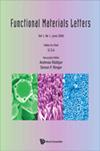Influence of 2D CuxAl(100−x) electrodes on the CuxAl(100−x)/Cu21(SiO2)79/W memristive device
IF 1.1
4区 材料科学
Q4 MATERIALS SCIENCE, MULTIDISCIPLINARY
引用次数: 0
Abstract
In recent years, 2D metal nanomaterials have emerged as a novel class of 2D materials owing to their unique physiochemical properties. In this paper, memristive devices (CuAl(BE)/Cu (SiO2)/W(TE)) were fabricated utilizing 2D CuAl materials with different compositions as electrodes. After exfoliation by sonication, the minimum thickness of the freestanding single layer of 2D Cu Alwas only 1.5 nm. Furthermore, the distribution of SET thresholds was determined by the composition of the 2D CuAlmaterials. The results suggest that the SET and RESET thresholds can be adjusted according to the composition of the 2D CuAlmaterials. The application of 2D metals as electrodes is promising for miniature memristive devices.
二维 CuxAl(100-x)电极对 CuxAl(100-x)/Cu21(SiO2)79/W 记忆器件的影响
近年来,二维金属纳米材料因其独特的物理化学特性而成为一类新型的二维材料。本文利用不同成分的二维 CuxAl (100-x) 材料作为电极,制备了记忆性器件(CuxAl(100-x)(BE)/Cu 21(SiO2)79/W(TE))。经超声剥离后,二维 Cux Al(100-x)独立单层的最小厚度仅为 1.5 nm。此外,二维 CuxAl(100-x)材料的成分决定了 SET 门限的分布。结果表明,SET 和 RESET 阈值可根据二维 CuxAl(100-x)材料的成分进行调整。二维金属作为电极在微型记忆器件中的应用前景广阔。
本文章由计算机程序翻译,如有差异,请以英文原文为准。
求助全文
约1分钟内获得全文
求助全文
来源期刊

Functional Materials Letters
工程技术-材料科学:综合
CiteScore
2.40
自引率
7.70%
发文量
57
审稿时长
1.9 months
期刊介绍:
Functional Materials Letters is an international peer-reviewed scientific journal for original contributions to research on the synthesis, behavior and characterization of functional materials. The journal seeks to provide a rapid forum for the communication of novel research of high quality and with an interdisciplinary flavor. The journal is an ideal forum for communication amongst materials scientists and engineers, chemists and chemical engineers, and physicists in the dynamic fields associated with functional materials.
Functional materials are designed to make use of their natural or engineered functionalities to respond to changes in electrical and magnetic fields, physical and chemical environment, etc. These design considerations are fundamentally different to those relevant for structural materials and are the focus of this journal. Functional materials play an increasingly important role in the development of the field of materials science and engineering.
The scope of the journal covers theoretical and experimental studies of functional materials, characterization and new applications-related research on functional materials in macro-, micro- and nano-scale science and engineering. Among the topics covered are ferroelectric, multiferroic, ferromagnetic, magneto-optical, optoelectric, thermoelectric, energy conversion and energy storage, sustainable energy and shape memory materials.
 求助内容:
求助内容: 应助结果提醒方式:
应助结果提醒方式:


